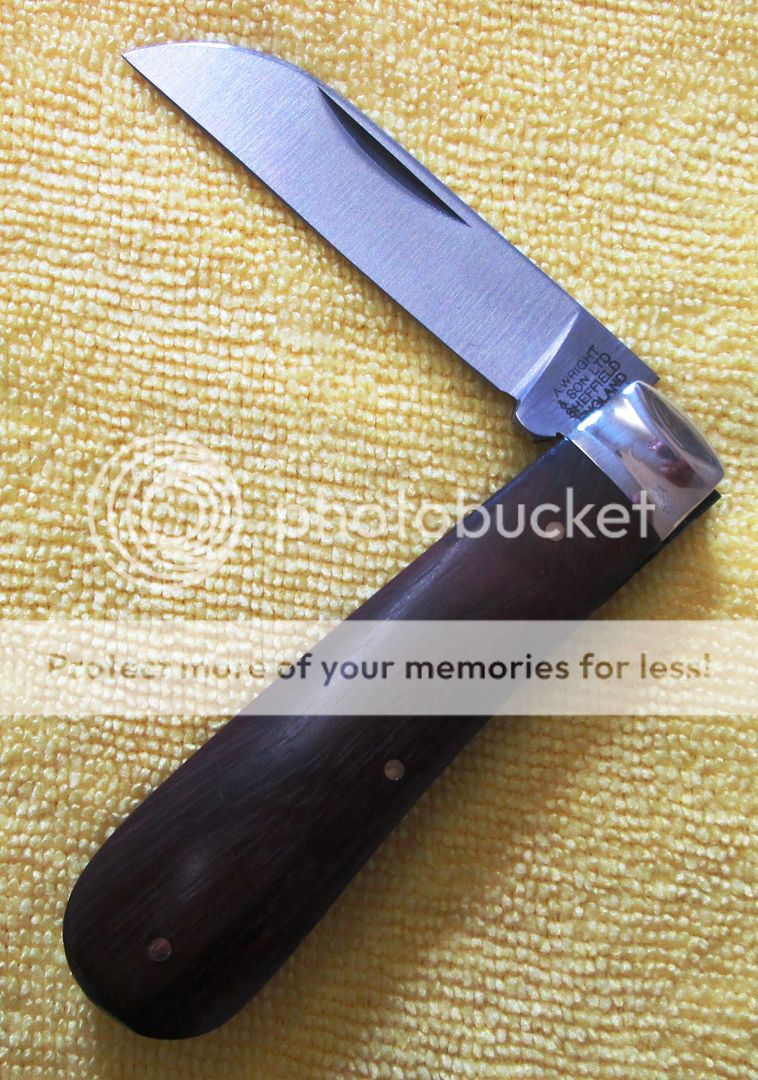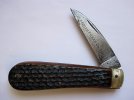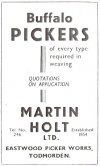So I've been carrying and using this A. Wright and Sons Tackler (along with a few other Wright knives) for almost a month now.
I'll make some general remarks on the Tackler pattern itself, followed by some comments on my specific knife and some 'tuning up' that was done to it.
Judging by the responses to this thread, the Tackler is a lesser known British pattern today. The Tackler's Wharncliffe style blade shape and swayback handle bear some similarities to the GEC 47 Viper pattern, although the Tackler has a bit of a stouter profile than the Viper.
I don't have a Viper to take a comparison photo with, but Charlie has posted one earlier in this thread.
Compared with my A. Wright Lambsfoot in ebony, the rosewood Tackler handle covers feel a bit more slimline in their contour, a little thinner in cross section.
The swayback handle is extremely comfortable both with the blade open and closed. It lends itself well to both pinch grip and hammer grip, and doing detail work with forefinger placed along the spine towards the tip.
The Tackler is a work knife for a 19th century industrial setting, and is interesting from that historical perspective as well. I imagine the large textile mills in the north of England and Ireland would have bought these by the gross, so its certainly a tried and tested pattern.
Over the past month I've used it for general EDC chores - slicing open packages and breaking down cardboard boxes for recycling, cutting errant bits of thread off of clothing etc. as well as a bit of food prep, slicing vegetables and peeling and sectioning fruit.
My 'woodworking' skills are limited to campfire related tasks like shaving tinder and feathersticking, so I'll be interested to hear from others as to whether the Tackler is also a good whittler.
It's a good, sturdy utility knife at a decent price - I paid less than $35USD for it. It excelled at doing what I would call the 'office knife work' above. It was a handy fruit peeler, a bit less suited to speed slicing of vegies on a cutting board due to the thin, very sharp tip scoring into the board - although this trait would probably also make it a good leatherworkers shop knife. I noticed that there is a leatherworkers website selling GEC 47 Vipers as work knives - the Tackler would be similarly suited to cutting and trimming material on benches.
Examining my example, there was a bit of refinement on the fairly coarse edge needed.
I did what I usually do with new knives and put it onto a flattened Chosera 400 waterstone to remove a bit of material behind the edge. As the edge bevel became more acute, it became apparent that the blade flats were slightly rippled. Usually this is because of uneven pressure while power grinding the blade flats, or too much taper from spine to edge, causing the ripple during heat treating and cooling. A lot of knives have this issue: I've seen it on Opinel, Sabatier and Queen knives before, to name a few. It's usually less apparent with an obtuse factory edge bevel. I evened up the edge bevel as best I could with finer stones and blended the shoulders in with fine (1500-2500 grit) wet'n'dry paper and some stropping. After doing two of the four Wright knives I bought in this way, the edge waviness was quite visually apparent, so on the last two, I just ground a straight 15 degree per side edge on with the Spyderco Sharpmaker diamond rods, then worked up to the Ultrafines.
The C70 carbon steel at around 55HRC takes a nice, fine edge and is very responsive to stropping and steeling.
The pull and snap on this Tackler was, shall we say,
robust. It was on the verge of being unusable for everyday chores, in fact. The traditional knives I use for work all have a clean, smooth, predictable walk'n'talk. When I'm opening and using a knife dozens of times a day - I don't want to be distracted by whether it's going to tear a thumbnail off, or fly out of my hand while I'm trying to close it.
I would normally give a new knife I'm testing a bit of a run as a camping or hiking knife too, but due to the fierce snap on the Tackler, it won't be used in that capacity.
I don't lend out all my knives and tools in camp, but usually have some general use knives to lend or show other people the use of particular blade shapes etc. Again, those knives need to be easy to use and control for knife using novices. The combination of razor-sharp straight edge and wild, unpredictable snap mean that this is not a knife I would hand to anyone but an experienced knife user.
I took some 6 micron diamond lapping paste and sparingly applied some to the bearing surfaces in the pivot action with a drop of oil, while working it open and closed for a while. After repeating a couple of times with a tiny amount of 3 and 1 micron paste, the pull and snap were still firm, but considerably smoothed out and more predictable. The excess paste was flushed out with camellia oil.
After a bit of an exterior polish with some clean leather with a dab of diamond compound, the Tackler has that cool, smooth, river rock feel in hand.
This is a great utility knife for the price, all things considered. It will go into my 'utility tool' knife group, along with my GEC 71 in O1 tool steel, my ebony Lambsfoot and a No. 10 Opinel.
I noticed A. Wright and Sons have a premium line with filework, high polish etc. I would gladly pay a bit more to have another, different 'premium line' which just focuses on getting essentials like the pull and walk'n'talk right, the edges and blades straight and centred, and parts which fit flush with each other. I like to think there's enough of a market now, that higher quality Sheffield pocketknives in traditional materials are still feasible in the 21st century.


















